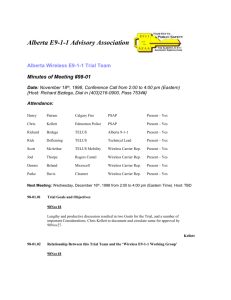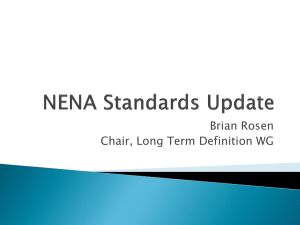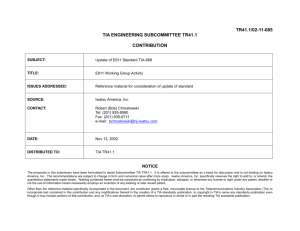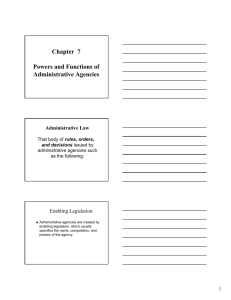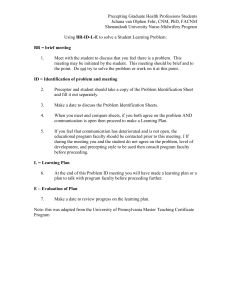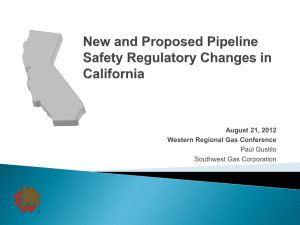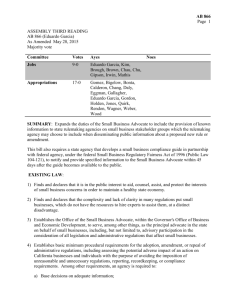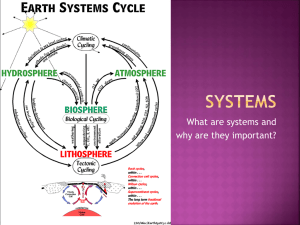CPUC Rule Making on Implementing 911 Services on
advertisement
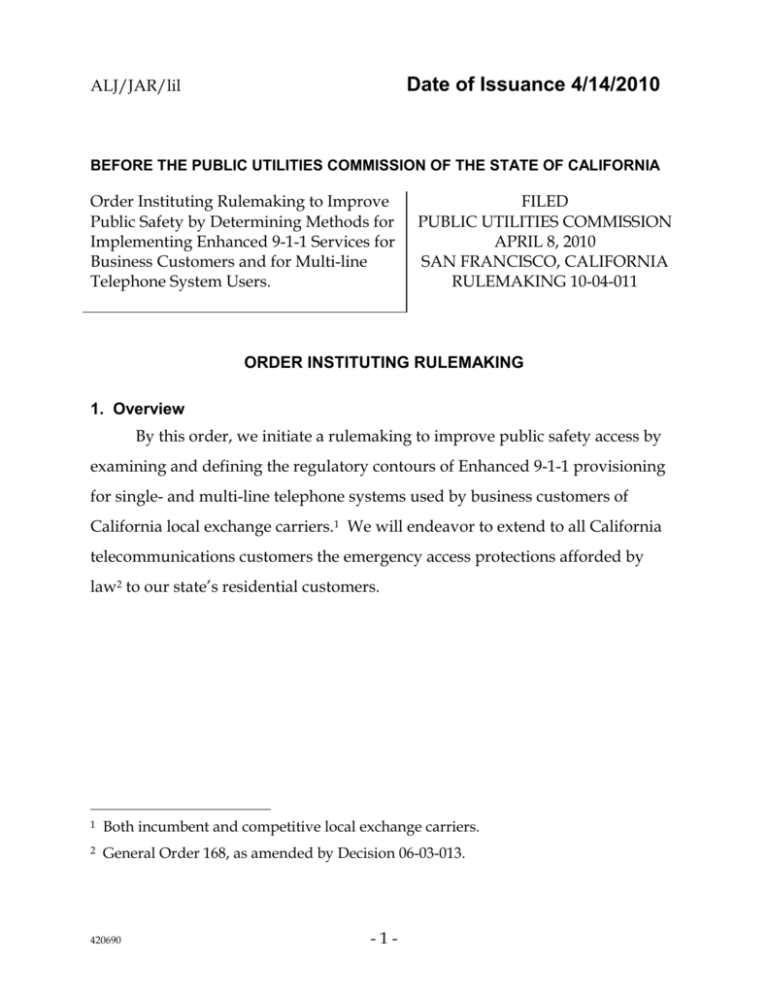
ALJ/JAR/lil Date of Issuance 4/14/2010 BEFORE THE PUBLIC UTILITIES COMMISSION OF THE STATE OF CALIFORNIA Order Instituting Rulemaking to Improve Public Safety by Determining Methods for Implementing Enhanced 9-1-1 Services for Business Customers and for Multi-line Telephone System Users. FILED PUBLIC UTILITIES COMMISSION APRIL 8, 2010 SAN FRANCISCO, CALIFORNIA RULEMAKING 10-04-011 ORDER INSTITUTING RULEMAKING 1. Overview By this order, we initiate a rulemaking to improve public safety access by examining and defining the regulatory contours of Enhanced 9-1-1 provisioning for single- and multi-line telephone systems used by business customers of California local exchange carriers.1 We will endeavor to extend to all California telecommunications customers the emergency access protections afforded by law2 to our state’s residential customers. 1 Both incumbent and competitive local exchange carriers. 2 General Order 168, as amended by Decision 06-03-013. 420690 -1- R.10-04-011 ALJ/JAR/lil 2. Background Like all Americans, for more than 30 years, Californians have depended on reaching local emergency services by dialing 9-1-1. Enhanced 911 (E9-1-1), in which the calling party's callback number3 and calling location4 are automatically delivered along with the voice call to the appropriate PSAP, has significantly advanced this critical service. In fact, E9-1-1 has proven to be essential to saving lives in those cases where the caller cannot verbally communicate his location or the voice call is discontinued and cannot be reestablished. In Decision (D.) 06-03-013, the Commission reaffirmed the relationship of E9-1-1 to public safety for residential customers, stating: [T]he role of government at issue here -- the promotion of public safety -- is independent of the marketplace. Significant public safety considerations justify the extension of 9-1-1 requirements to wireless carriers. For some time, state and local governments have relied on 9-1-1 as the critical communications element in providing police, fire protection and emergency health service. Although the marketplace will likely drive most providers to offer 9-1-1 services, we believe that it is better to adopt these 9-1-1 requirements, rather than create a situation in which the unavailability of 9-1-1 service becomes known only in an emergency.5 In subsequent decisions, mindful of the balance of regulation to protect consumers and the need for business to be able to explore the market, the Commission has consistently asserted the need for E9-1-1 coverage for all Through Automatic Numbering Identification, a number used by the Public Safety Answering Point (PSAP) to recontact the location from which the 9-1-1 call was placed. 3 4 By Automatic Location Identification. 5 D.06-03-013 at 67-68 (March 2, 2006). -2- R.10-04-011 ALJ/JAR/lil telecommunications consumers. In D.07-09-018, the Commission deregulated the pricing of telecommunications services other than basic residential service for certain incumbent local exchange carriers (ILECs). Prioritizing public safety, the Commission explicitly identified E9-1-1 protections to be excluded from the extant detariffing6 of these services: The 9-1-1 system provides the public an important public service that must be available to all phone customers and must not be detariffed.7 3. The Gap in E9-1-1 Service for Multi-Line Telephone Systems (MLTS) Private business, nonprofits, and government employed over 15 million Californians in 2007.8 Millions of other Californians routinely visit business facilities as shoppers, students, patients, and other customers. On an average day, about one million domestic and international tourists visit California's attractions, shopping centers, hotels and motels.9 Local exchange carriers (LECs) Detariffing allows a uniform regulatory framework carrier (URF Carrier) to cancel by advice letter a retail tariff currently in effect. In accordance with General Order (GO) 96-B, URF Carrier includes any ILEC that is regulated under the Commission's uniform regulatory framework (See, D.06-08-030), competitive local exchange carriers (CLECs), and interexchange carriers. 6 7 D.07-09-018 at 88 (September 12, 2007). California Size of Business -- Number of Businesses by Employment Size, Industry, and County, Table I: Number of Businesses, Number of Employees, and Third Quarter Payroll by Size of Business, State of California, Third Quarter, 2007, Labor Market Information Division, California Employment Development Department (http://labormarketinfo.edd.ca.gov). 8 California Travel and Tourism Commission (http://tourism.visitCalifornia.com/media/uploads/files/editor/California). 9 -3- R.10-04-011 ALJ/JAR/lil serve each of these entities as business customers,10 many of which use MLTS. LECs also categorize as business customers Shared Tenant Service (STS)11 providers, which provide telephone service to residents of older multi-tenant apartment buildings, condominiums and mobile home parks. Most business customers differ significantly from residential customers in the telecommunications services that are purchased and provisioned from LECs, especially if they require MLTS. The National Emergency Number Association (NENA) defines the MLTS as “a system comprised of common control unit(s), telephone sets, and control hardware and software. This includes network and premises-based systems, i.e., Centrex and private branch exchange (PBX), Hybrid, and Key Telephone Systems owned or leased by governmental agencies and nonprofit entities, as well as for-profit businesses."12 Business and residential lines represent 40 percent and 60 percent, respectively, of total switched access lines in California.13 In 2007, ILECs reported 7,114,082 business switched access lines. Pacific Bell Telephone Company This includes many residences such as college dormitories and assisted living facilities, which serve the most vulnerable segment of the community. 10 “Shared tenant service is a service provided through a PBX-type switch owned and operated by a customer of a telephone corporation,” 23 CPUC2d 554, 569 (January 28, 1987). 11 Industry Common Mechanisms for E9-1-1 Caller Location Discovery and Reporting Technical Information Documents, NENA 06-502, Version 1 at 6 (October 25, 2008). 12 Article 5 of the Public Utilities (Pub. Util.) Code requires California LECs to file annual reports which separately identify the number of residential and business access lines. Pursuant to D.08-09-015, URF ILECs must file Federal Communications Commission (FCC) Report 43-08, Operating Data Report including Table III – Access 13 Footnote continued on next page -4- R.10-04-011 ALJ/JAR/lil d/b/a AT&T California (AT&T California) and Verizon California Inc. (Verizon) provided service for 98.6 percent of that total.14 AT&T California and Verizon reported that 94.6 percent of their business lines were multi-line and 5.4 percent were single-line. When a party places an emergency 9-1-1 call from a telephone station served by an MLTS, such as PBX or Centrex, the PSAP receiving the call may not be able to identify the office, dormitory room, or other detailed location of the caller, unless the E9-1-1 database has been populated in advance with the granular location of the telephone station. As early as 1995, AT&T California recognized this gap in public safety in an advice letter which established the tariff item through which a private switch owner could voluntarily create E9-1-1 database records for each telephone station location, otherwise known as PS/ALI: Today, 9-1-1 calls placed from a PBX switch normally carries trunk number identification corresponding to the main address of the complex from which the call is placed, but no information as to the identity and location of the individual caller. This lack of a call back number, Automatic Number Identification (ANI) and the precise location information, Automatic Location Identification (ALI) can lead to 9-1-1 calls being routed to the wrong emergency agency, as well as delays in dispatching to the correct address.15 Lines in Service by Customer. General rate case LECs must file FCC Form M including Schedule S-3, Access Lines in Service by Customer. California LECs Year-2007 Total Company Number of Access Lines and Operating Revenues, Year 2007 Annual Reports. 14 15 Advice Letter 17852 (November 6, 1995). -5- R.10-04-011 ALJ/JAR/lil Since then, only 350 of California’s 1.3 million businesses, governmental entities and non-profits have provided PS/ALI records to the AT&T California E9-1-1 database,16 leaving most MLTS users without the E9-1-1 protections afforded to residential customers in GO 168, despite the recent technological and market-based advances in E9-1-1 services. Beginning in 1994 and through several proceedings, the FCC examined the problems of identifying the location of 9-1-1 callers using MLTS.17 In its E9-1-1 Report and Order and Second Further Notice of Proposed Rulemaking, the FCC expressed concern that "the lack of effective implementation of MLTS E9-1-1 could be an unacceptable gap in the emergency call system.”18 At the time, the FCC declined to adopt federal rules to address this issue, explaining that the record demonstrated that state and local governments are in a better position to devise such rules for their jurisdictions.19 In 2004, the FCC asked states how they were responding to the E9-1-1-MLTS/caller location issue. It also queried the states’ about their September 2007 AT&T California Main Station Report to the California 9-1-1 Emergency Communications Office. 16 See Revision of the Commission’s Rules to Ensure Compatibility with Enhanced 9-1-1 Emergency Calling Systems, CC Docket No. 94-102, Report and Order and Second Further Notice of Proposed Rulemaking (FNPRM), 18 FCC Record (Rcd) 25340, 25361-62, paras. 49-50 (2003) (E9-1-1 Report and Order and Second FNPRM). See also Revision of the Commission’s Rules to Ensure Compatibility with Enhanced 9-1-1 Emergency Calling Systems, CC Docket No. 94-102, IB Docket No. 99-67, FNPRM, 17 FCC Rcd 25576, 25605-07, paras. 82-85 (2002) (E9-1-1 Scope NPRM); and Revision of the Commission’s Rules to Ensure Compatibility with Enhanced 9-1-1 Emergency Calling Systems, CC Docket No. 94-102, Notice of Proposed Rulemaking, 9 FCC Rcd 6170, 6170-73, paras. 1, 8, 11, and 12 (1994). 17 18 Separate Statement of Commissioner Kevin J. Martin, FCC 03-290 at 73. 19 FCC DA 04-3874 at 2 (December 10, 2004). -6- R.10-04-011 ALJ/JAR/lil utilization of the Model Legislation on E9-1-1 for MLTS developed by NENA and the Association of Public-Safety Communications Officials (APCO). The FCC commented: [W]e believe that the Model Legislation submitted by NENA and APCO offers the states a valuable blueprint for their own laws [and] we strongly support the approach taken by the model legislation.20 Few states responded to the FCC’s public notice, and it did not issue a further public document on the matter. Among the numerous comments submitted, one carrier argued there was little need for federal rules since competitive E9-1-1 solutions were readily available for all MLTS systems from carriers and third parties, and because states were the best venue to address this issue.21 Following the FCC’s public notice and comment period, four states22 enacted new legislation adopting E9-1-1 requirements for MLTS, bringing the current total to sixteen.23 E9-1-1 Report and Order and Second FNPRM, 18 FCC Rcd at 25361-62, para. 50 and n. 179. 20 Verizon Communications’ comments in CC Docket No. 94-102, at 2-4 (February 28, 2005). 21 22 Alaska, Maine, Massachusetts, and Virginia. Alaska, Arkansas, Colorado, Connecticut, Florida, Illinois, Kentucky, Louisiana, Maine, Massachusetts, Minnesota, Mississippi, Texas, Vermont, Virginia, and Washington. Appendix D lists the legislative requirements for MLTs in the sixteen states. 23 -7- R.10-04-011 ALJ/JAR/lil On February 19, 2009, NENA released an update of the E9-1-1 Model Legislation for MLTS,24 stating that: . . . [t]he model legislation would ensure that 9-1-1 callers can be located when dialing from a business, shared tenant facility, hotel, or similar enterprise environment. Reflected in the language of the model legislation are technological advancements made in recent years that enable the implementation of Enhanced 9-1-1 (E9-1-1) MLTS capabilities without imposing undue burdens on MLTS manufacturers, providers and operators.25 In this Rulemaking, the Commission seeks input from LECs and other interested parties regarding the differences in E9-1-1 provisioning between residential and business customers; technical data related to E9-1-1 MLTS capabilities; the replacement cycle of MLTS equipment; and the standards for emergency services in California. We ask the LECs and other interested parties to review the technical and cost information provided in Appendices A and B respectively, and address the specific issues set forth in Appendix C to this order. 4. Small Business Exemption The primary public safety objective of addressing E9-1-1 MLTS requirements is to reduce the time needed to locate an injured or distressed 9-1-1 caller from an extensive workplace comprised of several rooms, floors, or buildings, or from residential units or mobile home spaces served by an STS, and to minimize the time and exposure of first responders to any dangerous conditions. Analysis of the NENA Model Legislation and other NENA technical NENA 06-750, Version 2 can be found at the NENA website: http://www.nena.org/standards/technical/data/mlts-model-legislation-2009. 24 25 NENA press release, February 19, 2009. -8- R.10-04-011 ALJ/JAR/lil documents26 suggests that approximately 95 percent of California businesses would not need to implement E9-1-1 MLTS solutions because their worksites are small enough for emergency responders to search through quickly. In 2007,27 1,304,291 businesses employed 15,747,249 Californians. Of that number, 1,247,919 were small businesses employing 49 employees or fewer, and representing 95.7 percent of the total number of California businesses. Since first responders are able to search smaller workplaces in a reasonable span of time, proposed rules regarding MLTS E9-1-1 requirements potentially could exempt more than 95 percent of all businesses in California.28 At the same time, the remaining 56,372 businesses, that employ 9,521,366 or 60.5 percent of the California workforce, would receive emergency services protections that could save countless lives and shield hundreds of millions of dollars in economic costs. Moreover, these businesses29 would most likely be customers of the newer, more efficient MLTS enterprise services, for which multiple vendors have developed E9-1-1 solutions.30 Appendix A to this Order provides a detailed description of the pertinent NENA provisions. 26 California Size of Business -- Number of Businesses by Employment Size, Industry, and County, Table 1: Number of Businesses, Number of Employees, and Third Quarter Payroll by Size of Business, State of California, Third Quarter, 2007, Labor Market Information Division, California Employment Development Department, http://www.labormarketinfo.edd.ca.gov/. 27 28 Employers with less than 50 employees. 29 Employers with 50 or more employees. Appendix A describes more fully several vendors’ MLTS E9-1-1 solutions. Appendix B discusses estimated MLTS costs to provide E9-1-1. 30 -9- R.10-04-011 ALJ/JAR/lil 5. Preliminary Scoping Memorandum Rule 7.1(d) of the Commission's Rules of Practice and Procedure (Rules)31 provides that an Order Instituting Rulemaking (OIR) shall attach a preliminary scoping memo. The scope of this proceeding will be to examine E9-1-1 provisioning for MLTS as well as for single-line telephone systems used by California LECs’ business customers and extend, through Commission rules, utility tariffs, contracts and interconnection agreements, or a proposal to the state legislature, the protections of E9-1-1 service to those telephone systems utilizing traditional analog voice telephony or fixed Voice over Internet Protocol telephony that are currently unprotected. To this end, we invite parties to comment on the questions and issues set forth in Appendix C as well as do make recommendations regarding further issues to be included in this proceeding. In their comments, parties may state any objections to the order regarding the need for hearings, issues to be considered, or the proposed schedule. 6. Category of Proceeding and Need for Hearing Rule 7.1(d) requires that an OIR preliminarily determine the category of the proceeding and the need for hearing. As a preliminary matter, we determine that this proceeding is “quasi-legislative,” as defined in Rule 1.3(d). We anticipate that the issues in this proceeding may be resolved through a combination of workshops and filed comments, and that evidentiary hearings will not be necessary. Any person or entity who objects to the preliminary categorization of this rulemaking as “quasi-legislative” or to the preliminary The Rules are codified at Chapter 1, Division 1 of the Title 20 of the California Code of Regulations. 31 - 10 - R.10-04-011 ALJ/JAR/lil hearing determination, shall state the objections in the opening comments, as described below. After considering the opening comments, the assigned Commissioner will issue a scoping ruling making a final category determination; this final category determination is subject to appeal as specified in Rule 7.6. 7. Schedule Parties are directed to file and serve comments on the scope and issues of this proceeding as proposed in the preliminary scoping memo within 30 days of the issuance of this rulemaking. There will be a workshop 30 days after the issuance of the scoping memo. The overall schedule is set forth below. April 8, 2010 Issuance of OIR May 10, 2010 Parties file Opening comments on scope and issues in Preliminary Scoping Memo and Appendix A June 2010 Scoping Memo July 2010 Workshop September 2010 Workshop Report issued October 2010 Parties file comments on Workshop Report February 2011 Proposed Decision mailed for comment March 2011 Final Decision on Commission agenda This proceeding will conform to the statutory case management deadline for quasi-legislative matters set forth in Pub. Util. Code § 1701.5. Accordingly, we anticipate that it will be resolved within 18 months of the issuance of the Scoping Memo in this matter. - 11 - R.10-04-011 ALJ/JAR/lil 8. Parties and Service List The rule development to be considered could affect all California ILECs and those California CLECs that provide service primarily to business customers. This rulemaking shall be served on the four California URF carriers, the Communications Branch of the Division of Ratepayer Advocates, The Utility Reform Network, the California Association of Competitive Telecommunications Companies, The California E9-1-1 Communications Office, the California Chapter of the NENA, The California Chapter of the Association of Public-Safety Communications Officials-International, The California State Sheriff’s Association, The California Fire Chiefs Association, The California Police Chiefs Association, The American Heart Association/American Stroke Association, Avaya, Nortel, Cisco Systems, Inc., Intrado Communications, 911 Enable, and RedSky Technologies. Both the MLTS equipment manufacturers’ and Voice over Internet Protocol providers’ participation will be integral in examining extant practices and processes as they relate to E9-1-1 services for business customers and MLTS users, and adapting E9-1-1 protections to MLTS. Thus, we encourage both entities to participate. Such service does not confer party status upon any person or entity, and does not result in that person or entity being placed on the service list for this proceeding. The following procedures regarding party status and inclusion on the service list shall be observed. While all California regulated telephone utilities may be bound by the outcome of this proceeding, only those who notify the Commission that they wish to be on the service list will be accorded service until a final decision is issued. After initial service of the OIR, the Commission’s Process Office will create a service list, which will be posted on the Commission’s website at - 12 - R.10-04-011 ALJ/JAR/lil www.cpuc.ca.gov. Any person or representative of an entity interested in monitoring or participating in this proceeding should send a letter to the Commission’s Process Office (process_office@cpuc.ca.gov), located at 505 Van Ness Avenue, San Francisco, California 94102. The letter should specify the docket number of this rulemaking in the subject line, and must include the name, address, phone number, organization and e-mail address of those who wish to be added to the service list. The letter should also specify whether the person wishes to to be a “Party” (i.e., one who actively participates in the proceeding by filing comments or appearing at workshops or hearings), “State Service” (i.e., employee of the State of California who will not be submitting comments), or “Information Only” (i.e., one who will not participate actively, but simply wishes to follow the proceeding and receive electronic service of all documents in this rulemaking). Those who seek party status should indicate how they intend to participate in the proceeding. Letters may be sent by either electronic mail or regular mail, but must be received by the Commission by May 10, 2010. In addition, pursuant to Rule 1.4(a), persons and entities may also gain party status by: (a) filing comments in this rulemaking, or (b) filing a motion to become a party at a later date. Those seeking party status through filing comments or by a subsequent motion shall comply with Rule 1.4(b).32 A party to a Commission proceeding has certain rights that non-parties (those in "State Service" and "Information Only" service categories) do not have. Rule 1.4(b) states that those seeking party status shall "(1) fully disclose the persons or entities in whose behalf the filing, appearance, or motion is made, and the interest of such persons or entities in the proceeding; and (2) show that the contentions will be reasonably pertinent to the issues already presented." 32 - 13 - R.10-04-011 ALJ/JAR/lil For example, a party has the right to participate in evidentiary hearings, file comments on a proposed decision, and appeal a final decision. A party also has the ability to consent to waive or reduce a comment period. Non-parties do not have these rights, even though they are included in the service list for the proceeding and receive copies of some or all documents. Parties are encouraged to serve documents electronically, in accordance with Rule 1.10 of the Commission's Rules and Resolution ALJ-188. Consistent with those rules, a hard copy of all pleadings shall be served concurrently on the assigned Administrative Law Judge. All comments and pleadings must be filed in this proceeding, and served on the current service list for this proceeding, as of the date service is undertaken. Commission service lists, updated on an ongoing basis, are available from the Commission's website: www.cpuc.ca.gov. Parties should ensure that they are using the most up-to-date service list by checking the Commission's website prior to each service/filing date. 9. Public Advisor Any person or entity interested in participating in this rulemaking and investigation that is unfamiliar with the Commission's procedures should contact the Commission's Public Advisor's Office in San Francisco at (415) 703-2074, (866) 849-8390, or e-mail public.advisor@cpuc.ca.gov; or in Los Angeles at (213) 576-7055, (866) 849-8391, or email public.advisor.la@cpuc.ca.gov. The Text Telephone number is (866) 836-7825. 10. Intervenor Compensation A party that expects to request intervenor compensation for its participation in this proceeding shall file its notice of intent to claim intervenor compensation in accordance with Rule 17.1 of the Rules. - 14 - R.10-04-011 ALJ/JAR/lil 11. Ex Parte Communications Pursuant to Rule 8.2(a), ex parte communications in this proceeding are allowed without restriction or reporting requirement. Findings of Fact 1. For more than 30 years, Californians have depended on reaching local emergency services by dialing 9-1-1. 2. E9-1-1, in which the calling party’s callback number and calling location are automatically delivered along with the voice call to the appropriate PSAP, has significantly advanced this critical service. 3. E9-1-1 has proven to be essential to saving lives in those cases where the caller cannot verbally communicate his location or the voice call is discontinued and cannot be reestablished. 4. LECs serve California's attractions, shopping centers, hotels, motels, and other facilities as business customers, many of which use MLTS. 5. Most business customers differ significantly from residential customers in the telecommunications services purchased and provisioned from LECs, especially if they require MLTS. 6. When a party places an emergency 9-1-1 call from a telephone station served by an MLTS, such as PBX or Centrex, the PSAP receiving the call may not be able to identify the office, dormitory room, or other detailed location of the caller, unless the E9-1-1 database has been populated in advance with the granular location of the telephone station. 7. Since 1995, only 350 of California's 1.3 million businesses, governmental entities and nonprofits have provided PS/ALI records to the AT&T California E9-1-1 database, leaving most MLTS users without the E9-1-1 protections - 15 - R.10-04-011 ALJ/JAR/lil afforded to residential customers in GO 168, despite the recent technological and market-based advances in E9-1-1 services. 8. Beginning in 1994, and through several proceedings, the FCC declined to adopt federal rules to address the problems of identifying the location of 9-1-1 callers using MLTS, and explained that the record demonstrated that state and local governments are in a better position to devise such rules for their jurisdictions. 9. The primary public safety objective of addressing E9-1-1 MLTS requirements is to reduce the time needed to locate an injured or distressed 9-1-1 caller from an extensive workplace comprised of several rooms, floors, or buildings, or from residential units or mobile home spaces served by an STS, and to minimize the time and exposure of first responders to any dangerous conditions. 10. Technical data suggests that approximately 95 percent of California businesses would not need to implement E9-1-1 MLTS solutions because their worksites are small enough for emergency responders to search through quickly. 11. Still, the remaining businesses that employ 60.5 percent of the California workforce would receive emergency services protections that could save countless lives and shield hundreds of millions of dollars in economic costs. Conclusions of Law 1. The Commission should open a rulemaking in order to improve public safety access by examining and defining the regulatory contours of E9-1-1 provisioning for single- and MLTS used by business customers of California LECs. 2. Given the emergency access protections afforded by GO 168 and D.06-03-013 to California's residential customers, it should be determined - 16 - R.10-04-011 ALJ/JAR/lil whether a consistent rule should be adopted to extend such protections to all California telecommunications customers. Therefore, IT IS ORDERED that: 1. In accordance with Rule 6.1 of the Rules of Practice and Procedure, the Commission institutes this Rulemaking on its own motion to improve public safety by determining methods for implementing Enhanced 9-1-1 services for business customers and for multi-line telephone system users. 2. The Commission’s Division of Ratepayer Advocates, Pacific Bell Telephone Company d/b/a AT&T California, Verizon California Inc., Citizens Telecommunications Company of California Inc., d/b/a Frontier Communications Company of California, and SureWest Telephone, and all other California LECs, The Utility Reform Network, the California Association of Competitive Telecommunications Companies, The California Fire Chiefs Association, The California State Sheriffs' Association, The California Police Chiefs Association, The California Chapter of the National Emergency Number Association, The California 9-1-1 Emergency Communications Office, The California Chapter of the Association of Public-Safety Communications OfficialsInternational, The American Heart Association/American Stroke Association, Avaya, Nortel, Cisco Systems, Inc., Intrado Communications, 911 Enable, RedSky Technologies, and other interested parties may file comments on May 10, 2010, in response to the preliminary scoping memo and the questions set forth in Appendix C, which is attached to this order. 3. In their comments, parties may also state any objections to the Order Instituting Rulemaking regarding the need for hearing, issues to be considered, or the proposed schedule. - 17 - R.10-04-011 ALJ/JAR/lil 4. Interested persons must follow the directions in this Order Instituting Rulemaking to become a party or to be placed on the official service list as a non-party. 5. The Commission's Process Office will publish the official service list on the Commission's website (www.cpuc.ca.gov) as soon as practicable. Parties may also obtain the service list by contacting the Process Office at (415) 703-2021. 6. Any party that expects to claim intervenor compensation for its participation in this Order Instituting Rulemaking shall file its notice of intent to claim intervenor compensation no later than 30 days from the date of the Scoping Memo in this proceeding. 7. This Rulemaking is preliminarily determined to be quasi-legislative, as that term is defined in Rule 1.3(d) of the Commission's Rules of Practice and Procedure. 8. This proceeding is preliminarily determined not to need a hearing. 9. The Executive Director shall cause this Order Instituting Rulemaking to be served on the four California Uniform Regulatory Framework carriers, the Communications Branch of the Division of Ratepayer Advocates, The Utility Reform Network, the California Association of Competitive Telecommunications Companies, The California Fire Chiefs Association, The California State Sheriffs' Association, The California Police Chiefs Association, The California Chapter of the National Emergency Number Association, The California 9-1-1 Emergency Communications Office, The California Chapter of the Association of Public-Safety Communications Officials-International, The American Heart Association/American Stroke Association, Avaya, Nortel, Cisco Systems, Inc., Intrado Communications, 911 Enable, RedSky Technologies, and other interested parties who may file comments on May 10, 2010, in response to the preliminary - 18 - R.10-04-011 ALJ/JAR/lil scoping memo and the questions set forth in Appendix A, which is attached to this order. 10. The expected timetable for this proceeding is as set forth in the body of this order. The assigned Commissioner by scoping memo and other rulings, and the assigned Administrative Law Judge by ruling with the assigned Commissioner’s concurrence, may adjust the timetable as necessary during the course of the proceeding, provided that in no instance shall this proceeding require longer than 18 months to complete after the scoping memo is issued. 11. Parties serving documents in this proceeding shall comply with Rule 1.10 of Commission’s Rules of Practice and Procedure regarding electronic service. Any documents served on the assigned Commissioner and Administrative Law Judge shall be by both electronic mail and by delivery or mailing a paper format copy of the document. 12. Ex parte communications in this Order Instituting Rulemaking are governed by Rule 8.2(a) of the Commission’s Rules of Practice and Procedure. - 19 - R.10-04-011 ALJ/JAR/lil This order is effective today. Dated April 8, 2010, at San Francisco, California. MICHAEL R. PEEVEY President DIAN M. GRUENEICH JOHN A. BOHN TIMOTHY ALAN SIMON NANCY E. RYAN Commissioners Appendix A to R.10-04-011 Appendix B to R.10-04-011 Appendix C to R.10-04-011 Appendix D to R.10-04-011 - 20 -
